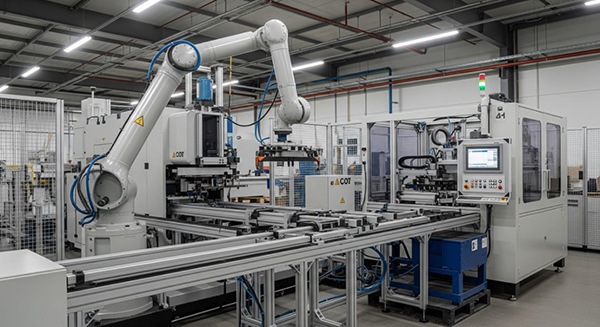It’s a harsh truth: America’s supply chains are now dominated by rivals we once trusted. In manufacturing, this new Cold War is red-hot and unfolding in plain sight.
by Amir Sharif
To keep costs competitive while reshoring, manufacturers must rethink operations. This is more than a business imperative—it’s a national security risk.
To understand the path forward, we must look backward.
The U.S. rose to global leadership in the 20th century not because of luck or rhetoric, but because our industrial muscle made the difference. Germany and Japan may have had technological superiority in many domains, but the U.S. drowned them in steel—building more ships, more tanks, and more aircraft. Then came the Cold War. While the Soviet Union relied on centralized command and collectivism, the U.S. leaned into capitalism and individual freedom.
After the Cold War, we invited the Chinese Communist Party into the world economy, expecting integration to lead to liberalization.
We were wrong.
In the pursuit of efficiency and short-term gains, the U.S. offshored the core of its strength—its manufacturing base.
Now, the U.S. is dangerously exposed. Manufacturing components critical to defense, energy, and healthcare are overwhelmingly foreign-made. Some in regions that could turn hostile tomorrow. We need to make changes now so we are not reliant on an adversary whose strategic doctrine views economic dependence as a lever of control.
But reshoring won’t be easy. There are two immediate challenges:
This is a formula for economic disaster. Rising costs + stagnant productivity = inflation. We cannot allow that to spiral. But there is a solution.

The solution is not more automation. It’s autonomy.
If you’ve used automation before—conveyor belts, pick-and-place robots, CNC machines—you know they follow rigid instructions. They do not adapt. They do not learn. They do not collaborate.
But autonomy is different. It brings intelligence to machines. Autonomy means robots that understand context, make decisions, and work alongside humans to amplify their productivity.
It’s the difference between a machine that obeys and a machine that assists.
Think of it this way: Spreadsheets didn’t replace accountants—they made them 10X more effective. Autonomous robots will do the same for your floor workers.
The shift to autonomy isn’t optional—it’s inevitable. Federal contracts increasingly demand U.S.-based production.
American manufacturing can’t win a price war against subsidized foreign labor, but it can win a productivity war through intelligent systems at home.
Here’s what’s at stake:
But getting there will require leadership.
Policies are shifting, technologies are maturing, and economic forces are driving change. Wait too long, and you risk not just falling behind, but being shut out of the next manufacturing era altogether.
Here’s what you must do:
1. Upgrade—Not Just for Automation, But for Autonomy
Automation has been the workhorse of modern manufacturing for decades. But automation is fundamentally limited—it executes predefined tasks exactly as instructed. It cannot respond to unexpected conditions, adapt to variability in production, or collaborate meaningfully with human workers.
Autonomy is the next leap forward. Autonomous systems can sense their environment, make real-time decisions, and adapt to changing conditions. That means a robot that reroutes itself when a pathway is blocked, a machine that adjusts parameters when it detects a material defect, or a system that balances workloads dynamically to prevent bottlenecks.
When you invest in new equipment, you should be asking:
This is not an incremental shift—it’s a multiplier effect. Moving from automation to autonomy can yield 5X–10X productivity gains without proportional increases in headcount or cost. If your equipment can’t deliver that kind of step change, you’re investing in yesterday’s technology.
2. Demand High Performance—And Prove It
In the old model, manufacturers accepted vendor claims on faith. You’d see a slick presentation, maybe a demo at a trade show, and sign a purchase order. That era is over.
Your competitive survival depends on measurable, demonstrable results. Every vendor who walks through your door should be prepared to answer three critical questions:
Require proof-of-performance trials before you commit. This could mean a one-week on-site pilot or a limited-run deployment that you measure against your own KPIs—throughput, defect rate, downtime, worker engagement.
The key is to reject vague promises like “increase efficiency” and demand quantifiable, defensible claims such as:
Also, remember that safety is non-negotiable. But safety alone is not enough. The technology must also create a measurable performance advantage over your current setup. If it doesn’t deliver both, it’s not a fit.
3. Shift from CapEx to OpEx—Buy Output, Not Machines
For decades, manufacturers have budgeted in terms of capital expenditure: purchase the machine, own the machine, maintain the machine. But this ties up massive amounts of capital in equipment that may be obsolete before it’s even depreciated.
In a market where both demand and technology evolve rapidly, you need flexibility. The new model is robots-as-a-service (RaaS)—or more broadly, manufacturing capacity as a subscription.
Here’s why this matters:
This approach also makes financial sense: converting CapEx to OpEx improves cash flow, preserves borrowing capacity, and makes it easier to adapt your manufacturing footprint to market realities.
Ask your suppliers directly:
This is not just a financial shift—it’s a strategic one. You’re buying the outcome you need, not the hardware you hope will produce it.
This is more than a manufacturing revolution—it’s a national imperative. Success means revitalizing industry, empowering workers, securing supply chains, and maintaining global leadership. Failure hands the future to regimes that reject freedom and competition.
Now is the moment to adopt autonomy, demand measurable results, and pay for performance—before competitors move ahead and the nation pays the cost of delay.

About the Author:
Amir Sharif is the COO of 3Laws Robotics, delivering high-performance, intelligent safety solutions for autonomous systems. He previously founded Aporeto, which was acquired by Palo Alto Networks, and led product and strategy at Opsani, culminating in its acquisition by Cisco AppDynamics. His leadership extends to serving as the first independent board director of Qwibie, strengthening its capabilities in AI and robotics safety. With over two decades of experience in AI, security, and robotics, Amir has consistently driven innovation and successful outcomes.
In this episode, I sat down with Beejan Giga, Director | Partner and Caleb Emerson, Senior Results Manager at Carpedia International. We discussed the insights behind their recent Industry Today article, “Thinking Three Moves Ahead” and together we explored how manufacturers can plan more strategically, align with their suppliers, and build the operational discipline needed to support intentional, sustainable growth. It was a conversation packed with practical perspectives on navigating a fast-changing industry landscape.